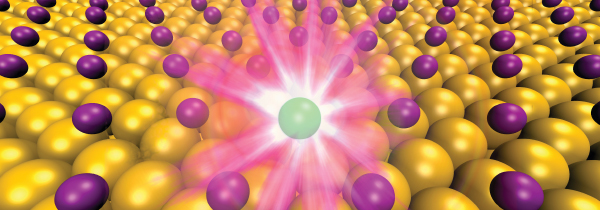 |
 |
||||||||||||||
| Discover Feat of Alchemy Bees in the Big City Not a Drop to Drink Development Redux Prenatal Tests and Maternal Cancer Health News from Tufts Mighty Submarine Act Create ConnectDepartments |

Feat of Alchemy
Scientists are the first to watch elements transform at atomic scale, a discovery that could lead to more-powerful and less-risky cancer treatmentsIn a research first, Tufts scientists have witnessed atoms of one chemical element morph into another—a feat of alchemy that could lead to safer, more effective cancer treatments.
Led by Charles Sykes, a professor of chemistry, the researchers worked with iodine-125—a radioactive form of the element iodine that is routinely used in cancer therapies. Using a scanning tunneling microscope, which can produce images of every atom in the surface of a material, they observed individual atoms of iodine-125 decay, each losing a proton and becoming tellurium-125, a non-radioactive isotope of the element tellurium. They reported their findings online in the journal Nature Materials on June 15.
The transformation occurred when the researchers infused a single droplet of water with iodine-125 and deposited it on a thin layer of gold. When the water evaporated, the iodine atoms bonded with the gold. The researchers inserted the tiny sample—smaller than a dime—into the microscope. Iodine-125 atoms have a half-life of fifty-nine days, meaning that at any time, any atom of the radioisotope can decay and become the isotope of tellurium. (Iodine and tellurium are neighbors on the periodic table of elements, numbers 53 and 52, respectively.)
While the sample contained trillions of atoms of iodine, it was impossible to predict when any particular atom would transmute into tellurium. The researchers worked up to eighteen hours a day for several weeks so they would be less likely to miss the transformations. Eventually, they took scanning tunneling microscope images that showed atom-sized spots all over the surface. In an international collaboration with theorists Angelos Michaelides and Philipp Pedevilla at University College London, the Sykes lab identified the features of newly formed tellurium atoms.
To verify that they had indeed seen the transformation, they took one of the samples and studied it over several months with an X-ray photoelectron spectrometer, used to determine the precise chemical makeup of materials. “By taking the measurement every week or two, we could see the chemical transmutation from one element to another,” as the sample went from mostly iodine to mostly tellurium, says Sykes.
Then Alex Pronschinske, a postdoctoral researcher in Sykes’ lab, suggested that they measure the electrons emitted by the sample without prodding from X-rays in the photoelectron spectrometer. In particular, he was interested in the emission of low-energy electrons, which have been shown to be quite effective in radiation oncology because they break cancer cells’ DNA into pieces.
They found that the gold-bonded iodine-125 emitted six times as many low-energy electrons as plain iodine-125. The reason was clear: the iodine-125 that had bonded to the gold “was acting like a reflector and an amplifier,” says Sykes. “If you shine any kind of radiation on a metal, you get this big flux of low-energy electrons coming out.”
Improving Cancer Therapies
The finding gave Sykes an idea: bond iodine-125 to nanoparticles of gold, affix the nanoparticles to antibodies targeting malignant tumors, and put it all in a liquid that could be injected into cancer patients.
Theoretically, the nanoparticles would attach to the tumor and emit low-energy electrons, destroying the tumor’s DNA. That would likely be an improvement over current radiation therapy protocols, in which doctors treat some cancers by putting different radioisotopes, including iodine-125, into tiny titanium capsules and implanting the capsules in tumors. Instead of making more low-energy electrons, as the gold-bound iodine does, the titanium capsules inhibit radiation, Sykes says, meaning these current therapies are less effective than they could be. Low-energy electrons can travel only one to two nanometers—a human hair is about 60,000 nanometers wide—so being attached to tumors, they would not affect healthy tissue and organs nearby.
Because gold-based nanoparticles eventually would be flushed out of the body, they would be safe to consume, Sykes says, unlike free iodine-125, which can accumulate in the thyroid gland and cause cancer. “Our discovery has great promise for improving cancer therapies,” he says.